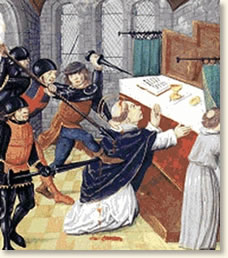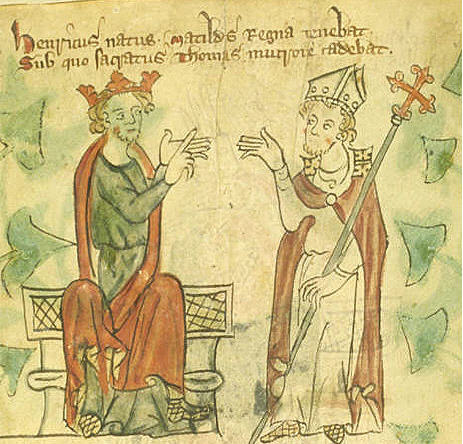Cotton Mather was a puritan minister who wrote a how-to book on strategies to seek out witches. He has a building at Harvard named after him.
Death by Cloak
The most complete account of the death of Hercules (also called Heracles) appears in a play by the ancient Greek dramatist, Sophocles. Hercules was presented with a cloak by his beautiful wife, Deianira. She had smeared it with a magic balm, which she had been told would make him love her forever. But she’d gotten the balm from a vengeful centaur, and the balm was actually a caustic poison. When Hercules put on the cloak, his body burned with pain and his skin began to corrode.
Sophocles’ graphic account of Hercules’ death shares remarkable similarities to the suffering of a smallpox victim. Sophocles wrote the play in 430 BC, when a smallpox epidemic was raging in Athens.
__________
Source: Mayor, Adrienne, Greek Fire, Poison Arrows, and Scorpion Bombs: Biological and Chemical Warfare in the Ancient World. (Overlook TP, 2008) page 121
Scalpel!
Prior to the acceptance of Germ Theory (at the end of the 19th century), it was common for surgeons to whet their knives on the soles of their shoes.
All that Glitters
German scientist Hennig Brand stored 50 buckets of urine in his cellar in 1675, hoping it would turn into gold. Instead it led to his discovery of the element phosphorous.
Ladybug, Ladybug, Fly Away Home
Those ladybugs you see in your house on warm days are Harmonia exyridis, a nonnative species of coccinellid beetle. The beetle was imported to control aphids, but the plan didn’t really work. They like to overwinter inside warm homes.
Reel Bugs: The Besieged Fortress
 The other day my husband excitedly tore open the newest Netflix envelope, only to discover it was a documentary about termites.
The other day my husband excitedly tore open the newest Netflix envelope, only to discover it was a documentary about termites.
But I was beyond excited. Ignoring his disbelieving look, I snatched it from his slack grip and popped it into the DVD. Besieged Fortress (2006) was enthralling.
Narrated by John Cusack (I love John Cusack), it stars a colony of termites on the African savannah, in Burkina Faso. The photography is extraordinary. The cameras are right there inside the labyrinth of tunnels, deep within the teeming termite metropolis.
Termites build huge mounds, entirely from mud and digested wood. They’re remarkable structures, thermo-regulated, designed for air circulation, and even providing an indoor garden for the mushrooms that help the termites digest cellulose.
You’re rooting for the termites the whole time. Their adorable little sightless eyes, the helpless nymphs, the awesome mandibles on the soldiers, the grotesquely enormous, immobilized queen, her swollen body pulsing with procreation.
And then you see the driver ants pick up the scent of the termite mound. Is your heart rate quickening?
I found myself yelling at the screen, telling them to watch out! Here come the driver ants! You see a large, scary-looking snake get swarmed, immobilized, and torn into itty bitty bite-sized bits by the ravenous army of ants. You feel sorry for the snake. And you know the poor termites–remember the cute termites, with their sightless, bulbous eyes? Yeah, those–will not stand a chance against these ants. When the driver ant soldiers do attack the mound, the ant queen stays back, sending her soldiers instructions via sounds and chemical signals.
There follows an epic battle that had me cringing in horror. I can’t believe they gave this a G rating. It makes Braveheart look like My Little Pony. The termite soldiers are impaled and dismembered, then carried off the battlefield to be eaten later. The worker termites fight to the death to protect their queen, and it’s more suspenseful than any movie I’ve seen in a very long time. I won’t tell you what happens.
I still can’t believe my husband went downstairs to watch the Sweet Sixteen.
Houp-là!
In 1961, the Museum of Modern Art hung a picture by Henri Matisse upside-down for 47 days before a museum patron notified them of the error.
Brushing Up
The first toothbrush was invented in China in 1498. It was made of Siberian pig bristles, wired into cattle bone handles.
Take Three Shots and Call Me in the Morning
The 18th Amendment (which banned alcohol) had a clause that permitted drink for medicinal purposes. This led to a huge increase in alcoholic medicines that were prescribed for any number of illnesses.
Scratch and Sniff
I had on an itchy wool sweater the other day that practically drove me bonkers. It got me thinking about how pious people in the Middle Ages wore hair shirts–usually a linen chemise lined on the inside with itchy, bristly horsehair–to atone for their sins and to mortify their flesh. As an added tormenting bonus, the shirts often became riddled with pesky bugs. Wearing such a shirt must have been deeply unpleasant. One of the most famous wearers of a hair shirt was Thomas à Becket (1118 – 1170).
Becket began wearing a hair shirt soon after he was appointed Archbishop of Canterbury. Perhaps his new clerical position made him feel a sudden urge to mortify his flesh. Perhaps he took to wearing this extremely uncomfortable garment out of remorse for the fun he’d had as the youthful companion to his old friend, King Henry II. Thomas’s change of attitude from party-boy to altar-boy dismayed the king, to say the least, and their friendship strained to the breaking point. Besides wearing the haircloth, Becket became a vegetarian (during a time when vegetables were reviled by the well-to-do). To top off his extreme virtuousness, every night Becket washed the feet of thirteen beggars.
Unfortunately Becket’s newfound piousness made him a lot of enemies among the nobility. In 1170 he was set upon by several armed noblemen and hacked to death at the altar of the cathedral in Canterbury.
 The dead archbishop was found to be wearing layer upon layer of clothing. Working from the outer layers inward, he had on a brown mantle, white surplice, fur coat of lambs’ wool, two woolen pelisses, a black cowled Benedictine robe, a shirt, and underneath it all, a linen chemise lined with itchy horse hair. This tormenting garment was riddled with biting insects. When the bugs that had been infesting the archbishop were exposed to the cold air, the hairshirt, in the words of one chronicler, “boiled over with them like water in a simmering caldron.”
The dead archbishop was found to be wearing layer upon layer of clothing. Working from the outer layers inward, he had on a brown mantle, white surplice, fur coat of lambs’ wool, two woolen pelisses, a black cowled Benedictine robe, a shirt, and underneath it all, a linen chemise lined with itchy horse hair. This tormenting garment was riddled with biting insects. When the bugs that had been infesting the archbishop were exposed to the cold air, the hairshirt, in the words of one chronicler, “boiled over with them like water in a simmering caldron.”
Members of the public were outraged by Becket’s murder, especially as the king was suspected of having had something to do with it. Stemming from what may have been true remorse, but also to atone publicly for any involvement he may have had in his ex -friend’s murder, King Henry promised the pope he would perform any penance required. The pope duly ordered the king to set forth on a long and arduous journey to Canterbury on foot. The weary monarch limped the last three miles into Canterbury on bare and bleeding feet.
As further penance, the king was assigned to wear Becket’s bug-ridden hair shirt.

